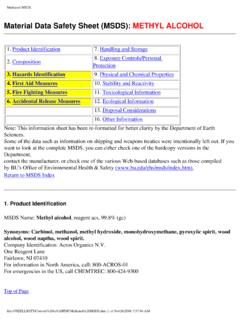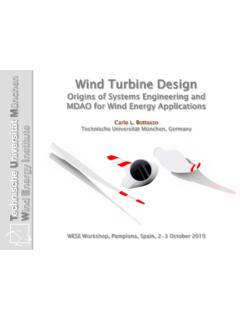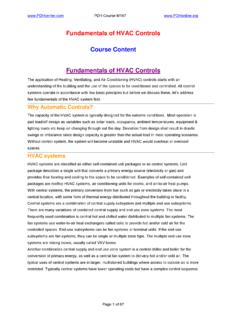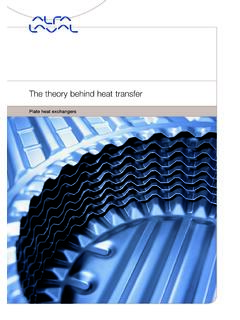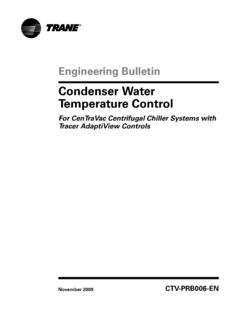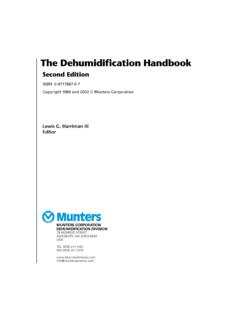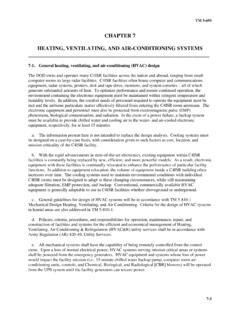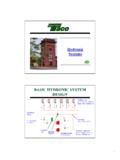Transcription of Andreas Linninger - University of Utah
1 DistillationSenior design CHE 396 Andreas LinningerInnovative SolutionsMichael RedelAlycia NovoaTanya GoldinaMichelle EnglertCHE-396 Senior design (Distillation)2 Table of ContentsIntroduction 3 Flowsheet 4 Limitations 5 Applicability 6 Theory 7 Case Study_____24 Alternatives 288 References 309 CHE-396 Senior design (Distillation)
2 3 IntroductionThis report examines the distillation process. This will enable the reader to understand thenecessary components along with distillation calculations. Distillation is a process thatseparates two or more components into an overhead distillate and bottoms. The bottomsproduct is almost exclusively liquid, while the distillate may be liquid or a vapor or separation process requires three things. First, a second phase must be formed so thatboth liquid and vapor phases are present and can contact each other on each stage withina separation column. Secondly, the components have different volatilities so that theywill partition between the two phases to different extent. Lastly, the two phases can beseparated by gravity or other mechanical means. Distillation differs from absorption andstripping in that the second phase is created by thermal means (Seader, 1998).CHE-396 Senior design (Distillation)4 FlowsheetThe distillation column contains one feed stream and two product streams.
3 The feedcontains a mole percent of the light component, ZF. The product stream exiting the tophas a composition of XD of the light component. The product stream leaving the bottomcontains a composition of Xb of the light component. The column is broken in twosections. The top section is referred to as the rectifying section. The bottom section isknown as the stripping top product stream passes through a total condenser. This effectively condenses all ofthe vapor distillate to liquid. The bottom product stream uses a partial reboiler. Thisallows for the input of energy into our Senior design (Distillation)5 Limitations Azeotropes: An azeotrope is a liquid mixture which when vaporized producesthe same composition as the liquid. If the mixture is azeotropic, then moreadvanced types of separation must be considered. More information onazeotropes maybe found in Douglas, Section Solids: If the material to be separated is high in solids, or contains tars orresins that could plug or foul a continuous unit, then a batch separation shouldbe considered (Perry s, 1997).
4 Optimum Pressure (King, 1980):1. Vacuum operation: Use of a vacuum should be considered for heat-sensitive compounds or polymerizable materials. Vacuum is usually notused unless required, , a low bottoms temperature is needed to avoidthermal Distillation column is above atmospheric pressure: Column shell shouldbe thicker to withstand pressure of the If the column pressure required to accomplish overhead condensation withcooling water is less than 250 lb/in2, then the column pressure should givean average temperature driving force of 5-15*C in the If the column pressure required accomplishing overhead condensationwith cooling water is greater than 250 lb/in2, then consider an alternativeof using a refrigerant on the overhead and running the column at a Senior design (Distillation)6 Optimum Temperature Differences in Reboilers and Condensers (King,1980):1. Reboiler temperatures should be kept low enough to avoid bottomsdegradation and/or Common temperature differences used for heat exchange across reboilersand condensers are shown in the following table:Temp, KCondenser:Refrigeration3-10 Cooling Water6-20 Pressurized Fluid10-20 Boiling Water20-40 Air20-50 Reboiler:Process Fluid10-20 Steam10-60 Hot Oil20-60 Applicability Distillation is the least expensive means of separating mixtures of liquids.
5 If relative volatilities of components is less than , distillation becomes veryexpensive (Douglas, 1988) and extraction or reactive distillation should Senior design (Distillation)7 TheorySection 1. Graphical Determination of a Distillation Column DesignStep 1. Determine Process Operation Variables Assumed feed rate, composition, purity of distillate and bottoms, and the quality ofthe feed are known. Perform overall material and component balances to determine the compositions ofthe distillate and *ZF=XD*D+XB*B(1)F=D+B(2)whereFFeed rate of input streamZFComposition of light component in feedXD*Mole Fraction of light in distillateXB*Mole Fraction of light in BottomDTotal distillate amountBTotal bottom amount*If more than two components, these values are the light-key and heavy-key 2. Determine the Minimum Reflux RatioThis graphical approach is determined using the McCabe-Thiele Method for binarymixtures.
6 The ratio of reflux flow to distillate flow is called the reflux Senior design (Distillation)8 AssumptionsThe following assumptions are implied when using this method (McCabe,1993):a. Constant Molal Overflow. The molar flow rates of the vapor andliquid are nearly constant in each section of the column. This alsoensures the operating lines are straight Heat Effects are negligible. For example, heat losses to and fromthe column are small and For every mole of vapor condensed, another mole of liquid The liquid and vapor leaving the tray is in equilibrium with thevapor and liquid entering the an equilibrium curve is not given, draw a y-x diagram (y representing the vaporphase and x the liquid). The equilibrium curve can be obtained by relating therelative volatility to the composition of the liquid:y = *x/(1+x( -1))(4) This shows the bubble-point and dew point of a binary mixture at constantpressure.
7 An equilibrium line describes the compositions of the liquid and vaporin equilibrium at a fixed pressure. The equilibrium line crossing the forty-fivedegree line is an indication of an azeotropic mixture. An azeotrope is a liquidmixture which when vaporized produces the same composition as the liquid. Ifthe mixture is azeotropic, then more advanced types of separation must Senior design (Distillation)9 Forty Five Degree Line1. Draw the diagonal line connecting the points ( , ) to ( , ).This is your forty-five degree line. Feed Line (q-Line)2. The feed line can be constructed by locating the point on the forty-five degree line that corresponds to the feed composition. Thispoint can be extended with a slope of q/(q-1) where q is the feedquality. The feed line can be directly plotted through the followingequation:y=q/(q-1)X - ZF/(q-1)(5) Upper Operating Line3. Draw the operating line for the enriching section.
8 First find thedesired top product composition (on the x-axis) and locate thecorresponding point on the forty-five degree line. Connect thispoint to the point where the equilibrium cure and the feed lineCHE-396 Senior design (Distillation)10intersect. This is the upper operating line. The y intercept of thisline is equal to XD/(R+1). The following equation can be used todetermine the minimum reflux:Rmin=(XD/yintercept ) 1(6) Lower Operating Line4. Draw the operating line for the stripping section. First find thedesired bottom product composition (on the x-axis) and locate thecorresponding point on the forty-five degree line. Draw a line fromthis point to the intersection of the equilibrium curve and the feedline. This is your lower operating line. The slope of this line isequal to (Vbmin+1)/Vbmin where Vb is the boilup ratio. Theboilup ratio is the fractional amount of liquid that is boiled backinto the column to the amount of liquid 3.
9 Choose Actual Reflux Ratio:As the reflux ratio increases, the number of trays and thus the capital cost of the columndecreases. However, as a trade-off, an increase in reflux ratio will also increase the vaporrate within the tower, thus increasing expenses such as condensers and reboilers (4).Most columns are designed to operate between and times the minimum refluxratio because this is approximately the region of minimum operating cost. Therefore,based on first estimates, the operating reflux ratio is equated so that (Douglas, 1988): Ractual =Rmin* (7)CHE-396 Senior design (Distillation)11 Step 4. Determine the Minimum Number of Trays Upper/Lower Operating Line at Actual Reflux1. Redraw the upper and lower operating line using the actual reflux ratio. Plot thepoint XD/(R+1) and draw a line to the XD. The equation of the upper operating lineis:y=(R/R+1)*X+XD/(R+1)(8)The equation for the lower operating line can be drawn by connecting the XB tothe intersection of the feed line and the upper operating line.
10 The equation of thelower operating line is:y=((VB+1)/VB)*X+XB/VB(9) Determine Number of Trays2. Starting from composition of the distillate, a horizontal line is drawn to theequilibrium curve. This line demonstrates the first From the previous intersection, drop vertically until the upper operating line isobtained. Follow step two to determine next Senior design (Distillation)124. Continue stepping until the liquid composition ends equals the desired The total number of steps is equal to the theoretical number of When high conversions are desired, the stepping method may cause difficulties. In these cases the Kremser equation should be used. (10)where NNumber of trays in unreadable region mSlope of the line in unreadable region V/LR/(R+1) yin Conveniently chosen point below unreadable region yout XD for rectifying section ye,out m*XD+b (where b is the y intercept of new equil.)


